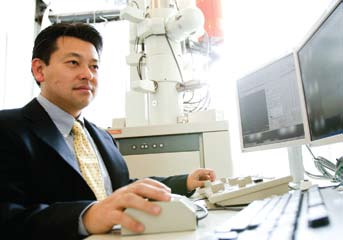As a scientist with the National Center for Electron Microscopy at Lawrence Berkeley National Laboratory, Masashi Watanabe played a major role in taking electron microscopy to a historic threshold – the imaging of features less than 1 angstrom in size.
Watanabe was a natural fit for the so-called TEAM (Transmission Electron Aberration-corrected Microscope) project. In previous work in Japan and at Lehigh, the only university in the world with two aberration-corrected transmission electron microscopes, he had become one of a handful of scientists capable of drawing maximum benefit from the specially equipped TEMs.
In January 2009, Watanabe returned to Lehigh as associate professor of materials science and engineering and a key player in the university’s Nano-characterization Laboratory.
With their ability to resolve images of individual atoms, and to identify those atoms’ chemical composition, says Watanabe, Lehigh’s aberration-corrected TEMs will lead to an improved knowledge of the way in which engineering materials and functional nanomaterials behave at the nanoscale.
One of Watanabe’s aims at Lehigh will be to analyze impurities at grain boundaries, a phenomenon critical to material failures. For example, he says, minute amounts of phosphorus or sulfur at grain boundaries can cause steel to become more brittle.
“We will identify where and how much impurity is present, then determine the threshold at which the materials become brittle. The amount may be as low as a single impurity atom. We need atomic-level resolution to analyze such low amounts of impurities. These instruments make this kind of analysis possible.”
Watanabe has pioneered several analytical techniques that enable more efficient data gathering. Working with HREM Research Inc. of Japan, he helped develop and commercialize Lehigh software that analyzes large-scale datasets from microscopes.
“I look forward to expanding our research capabilities at Lehigh,” he says. “We have state-of-the-art microscopes. And I have so many friends that I think we can assemble a strong team to attack some important challenges.”

